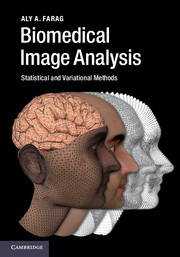Book contents
- Frontmatter
- Dedication
- Contents
- Preface
- Nomenclature
- 1 Overview of biomedical image analysis
- Part I Signals and systems, image formation, and image modality
- Part II Stochastic models
- Part III Computational geometry
- Part IV Variational approaches and level sets
- Part V Image analysis tools
- 11 Segmentation: statistical approach
- 12 Segmentation: variational approach
- 13 Basics of registration
- 14 Variational methods for shape registration
- 15 Statistical models of shape and appearance
- Index
- References
11 - Segmentation: statistical approach
from Part V - Image analysis tools
Published online by Cambridge University Press: 05 November 2014
- Frontmatter
- Dedication
- Contents
- Preface
- Nomenclature
- 1 Overview of biomedical image analysis
- Part I Signals and systems, image formation, and image modality
- Part II Stochastic models
- Part III Computational geometry
- Part IV Variational approaches and level sets
- Part V Image analysis tools
- 11 Segmentation: statistical approach
- 12 Segmentation: variational approach
- 13 Basics of registration
- 14 Variational methods for shape registration
- 15 Statistical models of shape and appearance
- Index
- References
Summary
Introduction
Segmentation is a fundamental step in understanding images. As image formation involves various sensor types, and objects vary in complexities of shape, spatial support, texture, and color, and the circumstances of the scenes may not be fully understood in advance, various approaches and algorithms for image segmentation have evolved over the years. In this book we address the basic issues in image segmentation: this chapter and the next will consider statistical and variational calculus approaches for segmentation. The focus will be on general frameworks which can be altered according to the specifics of the objects in the image, and the models used.
This chapter describes an unsupervised maximum-a-posteriori (MAP) based segmentation framework of N-dimensional multimodal images, in which objects occupy distinct, albeit overlapping, domains in the intensity histogram. The input image and its desired map (labeled image) are described by a joint Markov–Gibbs random field (MGRF) model of independent image signals and interdependent region labels. These models were discussed in Chapter 6. We deploy the kernel approach of Chapter 7 to model the joint and marginal probability densities of objects from the gray-level histogram, which incorporates a generalized linear combination of Gaussians (LCG), where the weights of the kernels may take positive and negative values, while maintaining the positivity and integrability constraints. The number of classes is estimated using a maximum likelihood approach applied to the LCG model. An approach is devised for MGRF model identification based on region characteristics. The segmentation process is conducted by using the LCG-model to provide an initial segmentation (pre-labeled image), and then a subsequent algorithm iteratively refines the labeled image using the MGRF. The convergence of the algorithm is examined, and a sensitivity analysis is performed to quantify its robustness with respect to initialization, improper estimation of the number of classes, and discontinuities in the objects. We illustrate the effectiveness of this approach for modeling and segmentation of objects (structures) in synthetic and biomedical images.
Information
- Type
- Chapter
- Information
- Biomedical Image AnalysisStatistical and Variational Methods, pp. 297 - 315Publisher: Cambridge University PressPrint publication year: 2014
